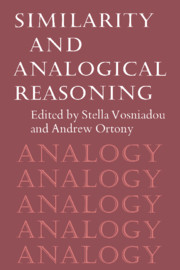Book contents
- Frontmatter
- Contents
- Preface
- List of contributors
- Similarity and analogical reasoning: a synthesis
- Part I Similarity and the structure of concepts
- Part II Analogical reasoning
- 7 The mechanisms of analogical learning
- 8 A computational model of analogical problem solving
- 9 Use of analogy in a production system architecture
- 10 Toward a microstructural account of human reasoning
- 11 Analogy and the exercise of creativity
- 12 Comments on Part II: Levels of description in information-processing theories of analogy
- 13 Comments on Part II: The role of explanation in analogy; or, The curse of an alluring name
- Part III Similarity and analogy in development, learning, and instruction
- Afterword: Comments on Parts I, II, and III: A framework for a theory of comparison and mapping
- Name index
- Subject index
7 - The mechanisms of analogical learning
Published online by Cambridge University Press: 22 October 2009
- Frontmatter
- Contents
- Preface
- List of contributors
- Similarity and analogical reasoning: a synthesis
- Part I Similarity and the structure of concepts
- Part II Analogical reasoning
- 7 The mechanisms of analogical learning
- 8 A computational model of analogical problem solving
- 9 Use of analogy in a production system architecture
- 10 Toward a microstructural account of human reasoning
- 11 Analogy and the exercise of creativity
- 12 Comments on Part II: Levels of description in information-processing theories of analogy
- 13 Comments on Part II: The role of explanation in analogy; or, The curse of an alluring name
- Part III Similarity and analogy in development, learning, and instruction
- Afterword: Comments on Parts I, II, and III: A framework for a theory of comparison and mapping
- Name index
- Subject index
Summary
It is widely accepted that similarity is a key determinant of transfer. In this chapter I suggest that both of these venerable terms – similarity and transfer – refer to complex notions that require further differentiation. I approach the problem by a double decomposition: decomposing similarity into finer subclasses and decomposing learning by similarity and analogy into a set of component subprocesses.
One thing reminds us of another. Mental experience is full of moments in which a current situation reminds us of some prior experience stored in memory. Sometimes such remindings lead to a change in the way we think about one or both of the situations. Here is an example reported by Dan Slobin (personal communication, April 1986). His daughter, Heida, had traveled quite a bit by the age of 3. One day in Turkey she heard a dog barking and remarked, “Dogs in Turkey make the same sound as dogs in America.… Maybe all dogs do. Do dogs in India sound the same?” Where did this question come from? According to Slobin's notebook, “She apparently noticed that while the people sounded different from country to country, the dogs did not.” The fact that only humans speak different languages may seem obvious to an adult, but for Heida to arrive at it by observation must have required a series of insights. She had to compare people from different countries and note that they typically sound different.
- Type
- Chapter
- Information
- Similarity and Analogical Reasoning , pp. 199 - 241Publisher: Cambridge University PressPrint publication year: 1989
- 511
- Cited by



